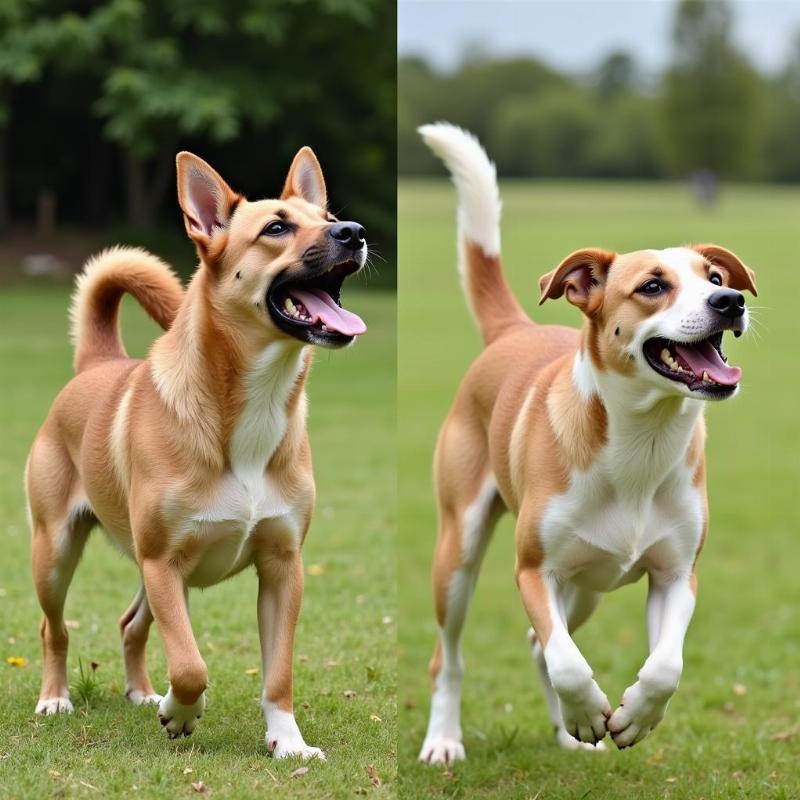The phrase “growl like a dog” likely brings to mind a deep, rumbling sound, a clear warning signal in the canine vocabulary. If you’re stuck on a crossword puzzle with “growl like a dog” as the clue, you’re in the right place. This article delves into the world of canine communication, focusing on the growl and its various interpretations, providing you with potential crossword answers and a deeper understanding of your furry friend.
Decoding the Dog Growl: More Than Just a Warning
While “growl” is often the go-to crossword answer, it’s important to understand the nuances of this vocalization. A growl isn’t always a sign of aggression. It can represent a range of emotions, from playful interaction to guarding resources. Context, body language, and the specific sound of the growl itself provide crucial clues to its meaning. Understanding these subtleties can significantly enhance your bond with your dog.
 Dog growling: Context and body language
Dog growling: Context and body language
Crossword Answers and Canine Communication
So, back to the crossword. While “GROWL” is the most common answer, other possibilities might include “SNARL,” “GRUMBLE,” or even “RUMBLE,” depending on the number of letters required. Understanding the context of the crossword puzzle itself can help narrow down the options. Is the puzzle themed around aggression, or perhaps playful sounds?
The Many Faces of a Growl: Context is Key
A dog’s growl can indicate a variety of emotions, including:
- Aggression: A deep, sustained growl accompanied by bared teeth, stiff body posture, and a fixed stare indicates a dog ready to defend itself or its resources.
- Fear or Anxiety: A higher-pitched, almost whiny growl coupled with tucked tail, lowered ears, and avoidance behavior suggests a fearful or anxious dog.
- Playfulness: A soft, breathy growl during play, often accompanied by a relaxed body posture and wagging tail, indicates a happy dog enjoying a game.
- Warning: A short, sharp growl can be a warning signal, telling another dog or person to back off.
- Pain or Discomfort: A low, guttural growl may be a sign that a dog is in pain or discomfort.
Responding to a Dog’s Growl: Safety and Understanding
Never punish a dog for growling. This suppresses a vital communication signal, and a dog that can’t growl might resort to biting without warning. Instead, focus on understanding the underlying cause of the growl.
Seek Professional Help: When to Consult a Veterinarian or Behaviorist
If your dog’s growling is frequent, intense, or accompanied by other concerning behaviors, consult a veterinarian or a certified dog trainer or behaviorist. They can help identify the root cause and develop a behavior modification plan.
Conclusion: Beyond the Crossword Clue
“Growl like a dog” is more than just a crossword clue. It’s a window into the complex world of canine communication. By understanding the various meanings of a growl, you can better interpret your dog’s emotions, strengthen your bond, and ensure both your safety and theirs. So, the next time you encounter this crossword clue, you’ll not only have the answer but also a deeper understanding of the fascinating language of dogs.
FAQs
-
Q: What does it mean when a dog growls at me?
A: A growl can indicate various emotions, including fear, aggression, possessiveness, or pain. Observe the dog’s body language to understand the context. -
Q: Should I punish my dog for growling?
A: No, punishing a growl can suppress this important communication signal. Address the underlying cause instead. -
Q: What are some other words for a dog’s growl?
A: Snarl, grumble, rumble, or even whine, depending on the specific sound. -
Q: When should I seek professional help for my dog’s growling?
A: If the growling is frequent, intense, or accompanied by other aggressive behaviors, consult a veterinarian or a certified dog behaviorist. -
Q: How can I tell if a dog’s growl is playful or aggressive?
A: Look at the dog’s body language. A playful growl is typically accompanied by a relaxed posture and wagging tail, while an aggressive growl involves stiff body language, bared teeth, and a fixed stare.
Beautdogs.us is your premier online destination for all things dog-related in the US. We offer expert advice on dog breeds, care, and products, catering to both novice and experienced dog owners. From understanding canine communication to choosing the right food, Beautdogs.us is your trusted resource for building a stronger bond with your furry friend. Contact us at [email protected] or +1 501-555-7529 for personalized guidance.